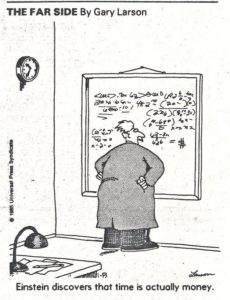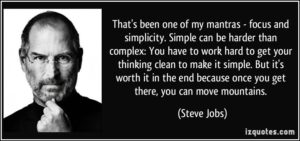I’ve been trying something new lately when it comes to meetings. I started by looking at the number of meetings I attend. I don’t think I am too far outside the norm by saying, I seem to attend a significant number of meetings. I think I have said this before. We may have hit the point where we seem to establish our credibility and measure our value contribution by the number of meeting we attend. We have now associated attending meetings with making progress.
I then started looking at what actual portion of the meeting was I actually engaged in or contributing to. I am sure there are those that would question my engagement or contribution to any meeting I attend or participate in.
The point here however, is that I found that there were specific portions or times during meetings where the topic being discussed was germane to me and I needed to be fully engaged and participative. The rest of the time, maybe not quite so much.
When I looked further at this relative “down” time I would experience in a meeting, I found that a significant portion of it was associated with what I will call “related” meeting topics, not the specific meeting topics. I’ll give an example.
I was in a project review meeting where the objective was to detail the status of the project. An issue was identified. This is a good thing. But it quickly caused the meeting to go off the rails. Instead of identifying the issue, and assigning those responsible to work out a resolution, those responsible for working out a resolution proceeded to try and work out their solution – during the review, with everyone else waiting to contribute their portions of the review.
The issue was important. But more so specifically to a subset of all those in attendance. The rest of the meeting attendees (myself included) time was less than efficiently spent listening to the attempted resolution of a topic that may not have been completely defined, or fully germane to their areas of focus.
In other words. We sat there on the call.
The meeting dragged on. Another issue was identified which created another attempt at an on-line resolution.
The meeting ran out of time so that those at the end of the agenda had to curtail their reports.
The meeting ran over the allotted time.
Parkinson’s Law was reaffirmed.
For those of you that are not familiar with Parkinson’s Law, according to Google, it is as follows:
“Work expands to fill the time available for its completion. A proverb coined by the twentieth-century British scholar C. Northcote Parkinson, known as Parkinson’s Law. It points out that people usually take all the time allotted (and frequently more) to accomplish any task.”
https://www.google.com/search?source=hp&ei=BhmlW5GQIsvzzgLem5qABg&q=work+expands+to+fill+time&oq=work+expands+&gs_l=psy-ab.1.0.0l2.1768.4291..6750…0.0..0.86.947.13……0….1..gws-wiz…….0i131j0i10.QQZmraKUhpQ
It seems that it may have its roots in science (Physics actually, and as we all know I am extremely fond of Physics).
”This law is likely derived from ideal gas law, whereby a gas expands to fit the volume allotted.”
https://en.wikipedia.org/wiki/Parkinson%27s_law
And as we all know, if it is science, it must be true.
As with any scientific theory, several corollaries have been created as a result.
“The first-referenced meaning of the law has dominated, and sprouted several corollaries, the best known being the Stock–Sanford corollary to Parkinson’s law:
“If you wait until the last minute, it only takes a minute to do.”
https://en.wikipedia.org/wiki/Parkinson%27s_law
Other corollaries include Horstman’s corollary to Parkinson’s law:
“Work contracts to fit in the time we give it.”
https://en.wikipedia.org/wiki/Parkinson%27s_law
All of this got me to thinking. And, as we also all know, this can be a dangerous situation for not only me, but all those involved or effected. It seems to me that meetings have taken on a status where it’s okay to ramble and take extra time, because invariably we make excuses for, or accept this kind of meeting behavior. The end result is that the meeting does achieve is goal, but it takes far more time than anyone is comfortable spending, and no one feels a sense of accomplishment when it is done.
My answer to this issue was pretty simple.
I made my meetings shorter.
Instead of having a one-hour review, once a week on Wednesdays, I scheduled two – one half hour reviews on Tuesday and Friday. I didn’t reduce the agendas or topics either. We covered everything in each meeting.
You might ask how this is possible? The answer is really very simple.
I became ruthless in cutting non-specific meeting discussions off.
If the meeting is a review, then it was a read-out, or reporting delivery only. If an issue was identified, it was immediately taken off-line, with an action item and an owner identified and would be resolved so that it could be read out and reported during the next half-hour call.
No exceptions.
It took a couple of meetings for the team to understand and get the rhythm of the approach, but the results have been very apparent. The project is moving faster. Ownership of issues and their resolution is much clearer. Progress is accelerated.
Just to review: we are spending the same total amount of time in meetings on the project reviews, but we are making more, and faster progress toward our objectives.
Looking back at Horstman’s Corollary to Parkinson’s Law, meaning if work expands to fill available time, that it should also contract to fit available time. Parkinson’s Law would mean if we schedule a one hour review we will conduct the meeting in such a way as to fill the full hour (and then some). Horstman’s Corollary would say that if we reduce the available time from one hour to a half-hour, we should be able to get the work done in that interval as well.
They both seem to be correct.
The issue is changing what were full hour meeting behaviors to the now necessary half-hour meeting behaviors. That means:
Ruthlessly staying on topic.
If it is a read-out meeting, read out only. Issues need to be taken off line, resolved and then read out at the next read-out meeting. If it is an issue resolution meeting, resolve the identified issue only. Don’t read out. Don’t work on other, related issues.
Cutting them off.
Many times, presenters do not know how to end their presentations. Sideline discussions, anecdotes, stories and all other manner of communications needs to be curtailed. Then move on.
Action Items.
Just because non-germane topics come up does not mean that they are not important topics. Clearly note them. Assign an owner and a time for resolution – and move on. Do not allow the group to lose focus on the topic at hand. This will keep everyone engaged.
Own it.
If it is your meeting, then it is your responsibility not to waste everyone else’s time. Stay on topic. Cut them off if necessary. Assign the action items. Publish the meeting minutes.
I didn’t set out to prove what are widely regarded as accurate, if not tongue-in-cheek axioms regarding how time is spent in business. I actually set out to see if I could start to reduce the amount of “down” time I was spending in meetings in general.
I am reasonably well convinced that the reason we have so much multi-tasking during meetings is due to the length and engagement requirements we now seem to expect in our meetings. We know the meeting will be longer than we want. We know that we will really only need to be fully engaged and aware for a relatively small percentage of the time that the meeting is conducted.
We know we will be bored the rest of the time.
The alternatives are to either multi-task, or to reduce the total time of the meeting in order to reduce the down time. Multi-tasking is the meeting attendee approach to solving their individual wasted meeting time issue. Reducing the actual meeting time is the meeting owner approach to solving everyone’s wasted meeting time issue.
Conducting shorter meetings will take significantly more effort on behalf of the meeting owner, and by extension some of the attendees, but I have found that you can actually get more done in the meeting by taking this approach. And I think that everyone in the meeting appreciates that, since that is supposed to be the objective of the meeting in the first place.




